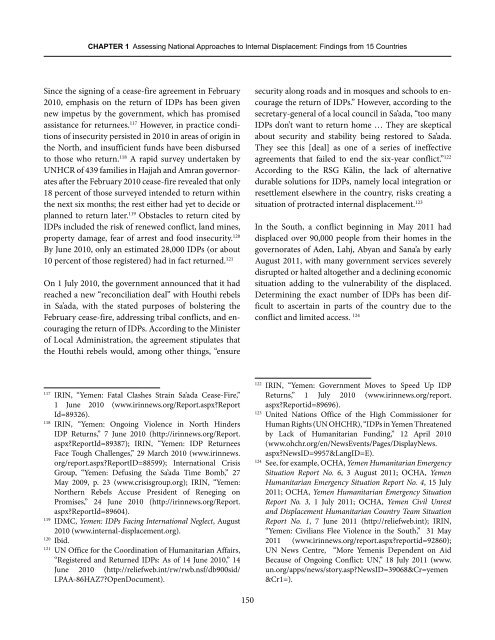From Responsibility to Response: Assessing National - Brookings
From Responsibility to Response: Assessing National - Brookings
From Responsibility to Response: Assessing National - Brookings
Create successful ePaper yourself
Turn your PDF publications into a flip-book with our unique Google optimized e-Paper software.
CHAPTER 1 <strong>Assessing</strong> <strong>National</strong> Approaches <strong>to</strong> Internal Displacement: Findings from 15 Countries<br />
Since the signing of a cease-fire agreement in February<br />
2010, emphasis on the return of IDPs has been given<br />
new impetus by the government, which has promised<br />
assistance for returnees. 117 However, in practice conditions<br />
of insecurity persisted in 2010 in areas of origin in<br />
the North, and insufficient funds have been disbursed<br />
<strong>to</strong> those who return. 118 A rapid survey undertaken by<br />
UNHCR of 439 families in Hajjah and Amran governorates<br />
after the February 2010 cease-fire revealed that only<br />
18 percent of those surveyed intended <strong>to</strong> return within<br />
the next six months; the rest either had yet <strong>to</strong> decide or<br />
planned <strong>to</strong> return later. 119 Obstacles <strong>to</strong> return cited by<br />
IDPs included the risk of renewed conflict, land mines,<br />
property damage, fear of arrest and food insecurity. 120<br />
By June 2010, only an estimated 28,000 IDPs (or about<br />
10 percent of those registered) had in fact returned. 121<br />
On 1 July 2010, the government announced that it had<br />
reached a new “reconciliation deal” with Houthi rebels<br />
in Sa’ada, with the stated purposes of bolstering the<br />
February cease-fire, addressing tribal conflicts, and encouraging<br />
the return of IDPs. According <strong>to</strong> the Minister<br />
of Local Administration, the agreement stipulates that<br />
the Houthi rebels would, among other things, “ensure<br />
117 IRIN, “Yemen: Fatal Clashes Strain Sa’ada Cease-Fire,”<br />
1 June 2010 (www.irinnews.org/Report.aspx?Report<br />
Id=89326).<br />
118 IRIN, “Yemen: Ongoing Violence in North Hinders<br />
IDP Returns,” 7 June 2010 (http://irinnews.org/Report.<br />
aspx?ReportId=89387); IRIN, “Yemen: IDP Returnees<br />
Face Tough Challenges,” 29 March 2010 (www.irinnews.<br />
org/report.aspx?ReportID=88599); International Crisis<br />
Group, “Yemen: Defusing the Sa’ada Time Bomb,” 27<br />
May 2009, p. 23 (www.crisisgroup.org); IRIN, “Yemen:<br />
Northern Rebels Accuse President of Reneging on<br />
Promises,” 24 June 2010 (http://irinnews.org/Report.<br />
aspx?ReportId=89604).<br />
119 IDMC, Yemen: IDPs Facing International Neglect, August<br />
2010 (www.internal-displacement.org).<br />
120 Ibid.<br />
121 UN Office for the Coordination of Humanitarian Affairs,<br />
“Registered and Returned IDPs: As of 14 June 2010,” 14<br />
June 2010 (http://reliefweb.int/rw/rwb.nsf/db900sid/<br />
LPAA-86HAZ7?OpenDocument).<br />
150<br />
security along roads and in mosques and schools <strong>to</strong> encourage<br />
the return of IDPs.” However, according <strong>to</strong> the<br />
secretary-general of a local council in Sa’ada, “<strong>to</strong>o many<br />
IDPs don’t want <strong>to</strong> return home … They are skeptical<br />
about security and stability being res<strong>to</strong>red <strong>to</strong> Sa’ada.<br />
They see this [deal] as one of a series of ineffective<br />
agreements that failed <strong>to</strong> end the six-year conflict.” 122<br />
According <strong>to</strong> the RSG Kälin, the lack of alternative<br />
durable solutions for IDPs, namely local integration or<br />
resettlement elsewhere in the country, risks creating a<br />
situation of protracted internal displacement. 123<br />
In the South, a conflict beginning in May 2011 had<br />
displaced over 90,000 people from their homes in the<br />
governorates of Aden, Lahj, Abyan and Sana’a by early<br />
August 2011, with many government services severely<br />
disrupted or halted al<strong>to</strong>gether and a declining economic<br />
situation adding <strong>to</strong> the vulnerability of the displaced.<br />
Determining the exact number of IDPs has been difficult<br />
<strong>to</strong> ascertain in parts of the country due <strong>to</strong> the<br />
conflict and limited access. 124<br />
122 IRIN, “Yemen: Government Moves <strong>to</strong> Speed Up IDP<br />
Returns,” 1 July 2010 (www.irinnews.org/report.<br />
aspx?Reportid=89696).<br />
123 United Nations Office of the High Commissioner for<br />
Human Rights (UN OHCHR), “IDPs in Yemen Threatened<br />
by Lack of Humanitarian Funding,” 12 April 2010<br />
(www.ohchr.org/en/NewsEvents/Pages/DisplayNews.<br />
aspx?NewsID=9957&LangID=E).<br />
124 See, for example, OCHA, Yemen Humanitarian Emergency<br />
Situation Report No. 6, 3 August 2011; OCHA, Yemen<br />
Humanitarian Emergency Situation Report No. 4, 15 July<br />
2011; OCHA, Yemen Humanitarian Emergency Situation<br />
Report No. 3, 1 July 2011; OCHA, Yemen Civil Unrest<br />
and Displacement Humanitarian Country Team Situation<br />
Report No. 1, 7 June 2011 (http://reliefweb.int); IRIN,<br />
“Yemen: Civilians Flee Violence in the South,” 31 May<br />
2011 (www.irinnews.org/report.aspx?reportid=92860);<br />
UN News Centre, “More Yemenis Dependent on Aid<br />
Because of Ongoing Conflict: UN,” 18 July 2011 (www.<br />
un.org/apps/news/s<strong>to</strong>ry.asp?NewsID=39068&Cr=yemen<br />
&Cr1=).

















